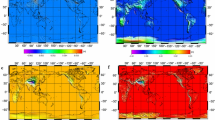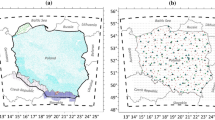Abstract.
Geoid determination by Stokes's formula requires a complete knowledge of the topographical mass density distribution in order to perform gravity reductions to the geoid boundary. However, deeper masses are also of interest, in order to produce a smooth field of gravity anomalies which will improve results from interpolation procedures. Until now, in most cases a constant mass density has been considered, which is a very rough approximation of reality. The influence on the geoid height coming from different mass density hypotheses given by the isostatic models of Pratt/Hayford, Airy/Heiskanen and Vening Meinesz is studied. Apart from a constant mass density value, additional density information deduced from geological maps and thick sedimentary layers is considered. An overview of how mass density distributions act within Stokes's theory is given. The isostatic models are considered in spherical and planar approximation, as well as with constant and lateral variable mass density of the topographical and deeper masses. Numerical results in a test area in south-west Germany show that the differences in the geoid height due to different density hypotheses can reach a magnitude of more than 1 decimetre, which is not negligible in a precise geoid determination with centimetre accuracy.
Similar content being viewed by others
Author information
Authors and Affiliations
Additional information
Received: 7 January 2002 / Accepted: 20 September 2002
M. Kuhn now at: Western Australian Centre for Geodesy, Curtin University of Technology, GPO Box U1987, Perth, WA 6845, Australia
Acknowledgements. The author would gratefully thank Prof. Dr.-Ing. B. Heck, who was the supervisor of my PhD thesis, and the second examiner Prof. Dr.-Ing. K.H. Ilk, as well as all other colleagues for their support of this work. Particular thanks go to the Landesvermessungsamt Baden–Württemberg (Survey Department of Baden–Württemberg), Bureau Gravimetrique International (BGI, France) for providing the gravity data and the Geologisches Landesamt Baden–Württemberg (Geological Department of Baden–Württemberg) for providing data and maps of the sediment layers within the Rhine Valley. Grateful thanks goes to Prof. W.E. Featherstone and the reviewers Prof. S.D. Pagiatakis, Dr. U. Marti as well as an unknown reviewer for their helpful comments on this paper.
Rights and permissions
About this article
Cite this article
Kuhn, M. Geoid determination with density hypotheses from isostatic models and geological information. Journal of Geodesy 77, 50–65 (2003). https://doi.org/10.1007/s00190-002-0297-y
Issue Date:
DOI: https://doi.org/10.1007/s00190-002-0297-y




